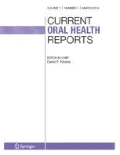Abstract
We are entering an age where health care providers, patients, and inevitably insurers will have access to unprecedented amounts of patient-level information from genetic sources that have a direct bearing on a patient’s risk, prognosis, and response to potential treatment for a number of diseases. This era of new genetics offers an implicit promise that with such detailed data will come improvements in patient outcomes. As the realization of the complexity of genomic data grows, the time at which the new genetics actually provides us with affordable and actionable information that improves patient outcomes is continually being pushed back. The degree to which clinical dental practice will be transformed by genomic science will depend ultimately on yet unanswered questions involving not just how fast these technology changes occur but also on the degree that we understand and manage associated issues, including patient ethics, dental care financing, dentist training, and effective use of the electronic health record.
Similar content being viewed by others
References
Papers of particular interest, published recently, have been highlighted as: • Of importance
Hart T, Hart S. Genetic studies of craniofacial anomalies: clinical implications and applications. Orthod Craniofacial Res. 2009;12(3):212–20.
Collins FS et al. A vision for the future of genomics research. Nature. 2003;422(6934):835–47.
Sanger F, Coulson AR. A rapid method for determining sequences in DNA by primed synthesis with DNA polymerase. J Mol Biol. 1975;94:441–8.
Sanger F et al. Nucleotide sequence of bacteriophage phi X174 DNA. Nature. 1977;265(5596):687–95.
Hattori M et al. The DNA sequence of human chromosome 21. Nature. 2000;405:311–9.
Watson JD, Jordan E. The human genome program at the national institutes of health. Genomics. 1989;5:654–56.
Pennisi E. ENCODE project writes eulogy for junk DNA. Science. 2012;337:1159–61.
Shaffer JR, Feingold E, Marazita ML. Genome-wide association studies: prospects and challenges for oral health. J Dent Res. 2012;91(7):637–41.
Burdett T et al. The NHGRI-EBI Catalog of published genome-wide association studies. Available at: www.ebi.ac.uk/gwas. Accessed 2 March 2016.
Shaffer JR et al. Genome-wide association scan for childhood caries implicates novel genes. J Dent Res. 2011;90(12):1457–62.
Stanley BOC et al. Genetic association of MPPED2 and ACTN2 with dental caries. J Dent Res. 2014;93(7):626–32.
Divaris K et al. Exploring the genetic basis of chronic periodontitis: a genome-wide association study. Hum Mol Genet. 2013;22(11):2312–24.
Vieira AR, Modesto A, Marazita ML. Caries: review of human genetics research. Caries Res. 2014;48:491–506.
Joyner MJ. ‘Moonshot’ medicine will let us down. New York Times; 2015. p A27.
Gritti L. The paradox of precision medicine. Scientific American online [Internet]. Available at: http://www.scientificamerican.com/article/the-paradox-of-precision-medicine/Access. 25 March 2016. This paper explores some important limitations of personalized medicine and emphasizes that cost-effectiveness needs to be considered.
Reis SE et al. Reengineering the national clinical and translational research enterprise: the strategic plan of the national clinical and translational science awards consortium. Acad Med. 2010;85(3):463–9.
Luce B, Cohen RS. Health technology assessment in the United States. Int J Technol Assess Health Care. 2009;25(Supplement 1):33–41.
Woolf SH. The meaning of translational research and why it matters. JAMA. 2008;299:211–3.
Larson EA, Wilke RA. The integration of genomics in primary care. Am J Med. 2015;128:1251.e1–5. This paper lays out the role of clinical informatics in translational genomics in primary care. The importance of lifetime follow up of genetic data is emphasized.
Lammi L et al. Mutations in AXIN2 cause familial tooth agenesis and predispose to colorectal cancer. Am J Hum Genet. 2004;74(5):1043–50.
Lloyd-Jones DM et al. Framingham risk score and prediction of lifetime risk for coronary heart disease. Am J Cardiol. 2004;94(1):20–4.
Featherstone JDB et al. Caries risk assessment in practice for age 6 through adult. Calif Dent Assoc J. 2007;35(10):703–13.
Bratthall D, Petersson GH. Cariogram—a multifactorial risk assessment model for a multifactorial disease. Community Dent Oral Epidemiol. 2005;33(4):256–64.
Pitts N. Caries risk assessment, diagnosis and synthesis in the context of a European core curriculum in cariology. Eur J Dent Educ. 2011;15 Suppl 1:23–31.
Lang NP, Suvan JE, Tonetti MS. Risk factor assessment tools for the prevention of periodontitis progression. A systematic review. J Clin Periodontol. 2015;42:S59–70.
Kornman KS, Polverini PJ. Clinical application of genetics to guide prevention and treatment of oral diseases. Clin Genet. 2014;86:44–9.
Schaefer AS et al. A genome-wide association study identifies GLT6D1 as a susceptibility locus for periodontitis. Hum Mol Genet. 2010;19:53–562.
Ginsubrgh GS, Willard HF. Genomic and personalized medicine: foundations and applications. Transl Res. 2009;154(6):277–87.
Coote JH, Joyner MJ. Is precision medicine the route to a healthy world? Lancet. 2015;385:1617.
Sonis ST. Genomics, personalized medicine, and oral disease. Boston: Springer International Publishing Switzerland; 2015.
Abrahams E. Personalized medicine realizing its promise. Gen Eng Biotechnol News. 2009;29(15):70–3.
American Medical Association and Medco Health Solutions. 59th Annual American society of human genetics conference. 2013.
Parikh RB, Kakad M, Bates DW. Integrating predictive analytics into high-value care: the dawn of precision delivery. JAMA. 2016;315(7):651–2.
Welch BM, Kawamoto K. Clinical decision support for genetically guided personalized medicine: a systematic review. J Am Med Inform Assoc. 2013;20:388–400.
Sharp RR. Downsizing genomic medicine: approaching the ethical complexity of whole-genome sequencing by starting small. Genet Med. 2011;13(3):191–4.
Van Ness B. Applications and limitations in translating genomics to clinical practice. Transl Res. 2016;168:1–5. This paper lays out the limitations that will need to be overcome before we can realize the full benefits of genetics and personalized medicine.
Author information
Authors and Affiliations
Corresponding author
Ethics declarations
Conflict of Interest
The author declares that he has no conflict of interest.
Human and Animal Rights and Informed Consent
This article does not contain any studies with human or animal subjects performed by any of the authors.
Additional information
This article is part of the Topical Collection on Dental Public Health
Rights and permissions
About this article
Cite this article
Weyant, R.J. The “New” Genetics and Its Impact on Oral Care Delivery. Curr Oral Health Rep 3, 140–146 (2016). https://doi.org/10.1007/s40496-016-0090-2
Published:
Issue Date:
DOI: https://doi.org/10.1007/s40496-016-0090-2



